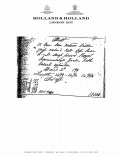Holland & Holland, 98 New Bond Street, London
12 bore 'Royal' Bar Action, Sidelock Ejector
No. 12536
Date of manufacture: 1889
Click on these images for more detail.
 |
|||
|
Heritage
Guns' Comment
|
The action is of combined Holland
& Robertson design and features:
Rounded action;
Bar action, 'Dip Edge', nine pin locks with bolstered tumbler pivots;
Double triggers bolted by an automatic top tang safety slide;
Breech face 'Gas Checks'; 'Block Patent Safety' interceptor sears;
Top lever operating a 'Purdey Bolt' by way of a 'Scott Spindle';
Top rib extension providing a 3rd bite;
Holland's patent cocking levers;
Holland & Robertson's patent ejector
and Anson's push rod forend catch.
Cased in Maker's leather &
brass case with some accessories.
Gun weight 7lb.
Engraving style Best Fine Bouquet & Scroll.
'"THE ROYAL" PATENT SAFETY HAMMERLESS EJECTOR' on underside
of action;
Top lever engraved 'HOLLAND & HOLLAND PATENT NO.23'. Gold inlaid
'SAFE'.
Trigger pulls measure approximately: Front trigger 3 ¼
lbs Rear trigger 4lbs.
The replacement steel barrels are 28" in length, chambered
for 2 3/4" (70mm) cartridges and are of brazed 'dovetail' construction
with soft soldered ribs.
Top rib is of concave game type. Bores are clean and bright.
London proof for 70mm nitro powder cartridges 1954-72.
Approximate barrel measurements at date of publication:
|
Nominal Proof Size
|
Bore Diameter 9" from Breech
|
Minimum Wall Thickness
|
Choke Constriction
|
|
| Right Barrel |
0.729"
|
0.730"
|
0.030"
|
0.09" (IC)
|
| Left Barrel |
0.729"
|
0.730"
|
0.031"
|
0.026" (Mod)
|
The Replacement Straight Hand Stock and Original
Splinter Forend are crafted from boldly figured walnut. The stock
is lightly cast off for a right-handed shot, features a vacant white
metal oval, well defined drop points and is finished with a 1 ¼"
leather covered recoil pad. There is one small inlet repair to the
forend edge and a second at the knuckle. The forend is fitted with
a finely engraved, steel forend tip, diamond and Anson pushrod tip.
The 26 lines per inch chequering has been freshened to normal
sidelock pattern
The stock is finished with a traditional linseed oil based
preparation as used on best guns by one of the top English makers.
This finish uses no grain fillers to achieve its deep, smooth lustre,
only many hours of alternate build and flatting off of the surface.
Approximate stock measurements at date of publication:
|
Pull to Heel
|
Pull to Bump
|
Pull to Centre
|
Pull to Toe
|
|
14 3/4"
|
14 7/8"
|
14 13/16"
|
15 1/8"
|
|
Drop at Comb
|
Drop at Face
|
Drop at Heel
|
|
1 9/16"
|
1 3/4"
|
2 3/8"
|
|
Cast-off at Comb
|
Cast-off at Heel
|
|
Negligible
|
3/16"
(approximate)
|
For the purposes of these measurements,
'Drop at Face' is the 'drop' measurement taken on a line perpendicular
to the
line joining the trigger and centre of the butt at approximately 8"
from the trigger (front trigger on a double trigger gun).
Patents Exhibited include:
Patents Exhibited include:
Scott's gas check patent no. 617 of 1882;
Needham & Hinton interceptor sears patent no. 706 of 1879;
Holland & Robertson's ejector patent no. 11623 of 1887;
'Purdey Bolt' patent no. 1104 of 1863;
'Scott Spindle' patent no. 2752 of 1865;
Scott's top extension patent no. 1902 of 1875;
Anson's forend fastener patent no. 3791 of 1872.








